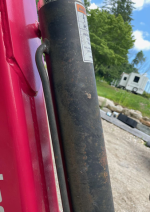You are using an out of date browser. It may not display this or other websites correctly.
You should upgrade or use an alternative browser.
You should upgrade or use an alternative browser.
What's the purpose of a bypass on a cylinder?
- Thread starter avz
- Start date
/ What's the purpose of a bypass on a cylinder?
#1
TractorTech
Veteran Member
- Joined
- Jan 26, 2012
- Messages
- 2,420
- Location
- California
- Tractor
- Ford 7710, Ford 550, Ford 1910, Ford 4430, KD Forklift, Ford LGT17H, New Holland L255 Skidsteer
What kind of equipment are you talking about? Engine? Diesel? Welded where?
jaxs
Elite Member
Bypass is used to (A) limit applied pressure (B) prevent pump deadheading at more than design pressure (C) prevent hose/line/pipe rupture due to over-pressurizing (D) prevent personal injury from high pressure explosion. (E) recirculate fluids to keep 2 or more solvents mixed and in suspension (F) recirculate fluids through cooler and/or filter.
Not an all inclusive list but enough to convince you bypass is a neccessary feature.
Not an all inclusive list but enough to convince you bypass is a neccessary feature.
Rich B1
Veteran Member
- Joined
- Jan 28, 2017
- Messages
- 1,120
- Location
- Stone Creek, OH
- Tractor
- NH TC21D, 3 Craftsman GT’s…..old but tough, AGT Industrial QH 12
Some cylinders have both ports located near each other to simplify hose routing. The tube is used to supply oil to the other end of the cylinder.
You will also see tubes welded on when the cylinder has a block on it for a holding valve.
You will also see tubes welded on when the cylinder has a block on it for a holding valve.
jb1390
Gold Member
You are probably seeing the line to pressurize the upper part of the cylinder. Lots of cylinders run that in hard line attached to the cylinder itself. Makes it so the flex hoses only need to be routed to the base of the cylinder.I've seen on some cylinders that there is a sort of a bypass tube (I guess that it's not the correct terminology) installed (welded) on them. could you please tell me what's the purpose of it? thanx.
Thanx for the comprehensive reply but I would like to understand how it works since as I understand, that bypass supplies the oil simultaneously to both sides (upper and lower) of the piston, which to my limited understanding, would've prevent it from moving, and yet, it works. what am I missing?Bypass is used to (A) limit applied pressure (B) prevent pump deadheading at more than design pressure (C) prevent hose/line/pipe rupture due to over-pressurizing (D) prevent personal injury from high pressure explosion. (E) recirculate fluids to keep 2 or more solvents mixed and in suspension (F) recirculate fluids through cooler and/or filter.
Not an all inclusive list but enough to convince you bypass is a neccessary feature.
jb1390
Gold Member
Read my first reply. I don't think what you are looking at is a bypass line. Typically a relief valve is included within the control valve. Not the cylinder.Thanx for the comprehensive reply but I would like to understand how it works since as I understand, that bypass supplies the oil simultaneously to both sides (upper and lower) of the piston, which to my limited understanding, would've prevent it from moving, and yet, it works. what am I missing?
For clarity, I'm assuming you are talking about a line like this one pictured?
Attachments
WranglerX
Super Member
Think you are looking at a steel tube that supplies hydraulic pressure to one side of cylinder/piston .... Mainly it bring both connection "ports" to same location so you don't need longer hose to go the side of piston further from the valve...
flyerdan
Veteran Member
The welded line is a feed to one of the ports, both to keep hose length shorter and keep from having a vulnerable hose exposed more than necessary. The double acting valve will feed pressure to one side only and allow the other side to flow to the return line.
There will be a bypass in the system, but it will be at the front of the valve body to prevent stuff from getting tore up from overpressure.
There will be a bypass in the system, but it will be at the front of the valve body to prevent stuff from getting tore up from overpressure.
LouNY
Super Star Member
- Joined
- Jul 4, 2015
- Messages
- 11,250
- Location
- Greenwich, NY
- Tractor
- Branson 8050, IH 574, Oliver 1550 Diesel Utility (traded in on Branson) NH 8160. Kioti CK2620SECH
There is a situation were cylinders may have a "bypass" it is when Rephasing cylinders are used in a multi cylinder application.

Rephasing Hydraulic Cylinder Solutions
Of course there are also pilot operated hydraulic check valves which will have some extra pipeing on them, they are handy devises at times and a pain in the butt other times.
They require that a cylinder is actively powered to operate they lock the fluid in a cylinder untill pressure is applied to move the cylinder they are the safety valves often used on manlifts and such equipment.
They are also found on more expensive hydraulic toplink cylinders.

Rephasing Hydraulic Cylinder Solutions
Of course there are also pilot operated hydraulic check valves which will have some extra pipeing on them, they are handy devises at times and a pain in the butt other times.
They require that a cylinder is actively powered to operate they lock the fluid in a cylinder untill pressure is applied to move the cylinder they are the safety valves often used on manlifts and such equipment.
They are also found on more expensive hydraulic toplink cylinders.


